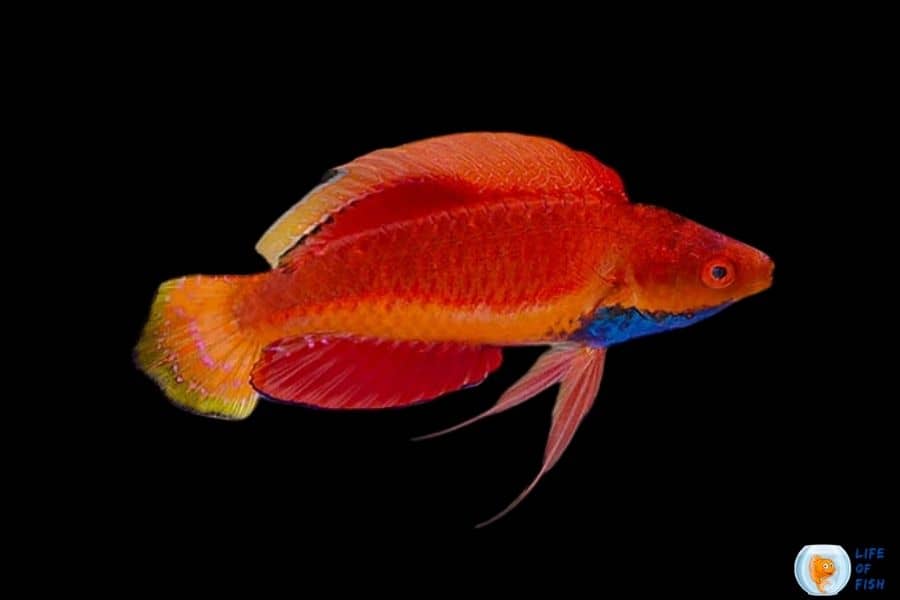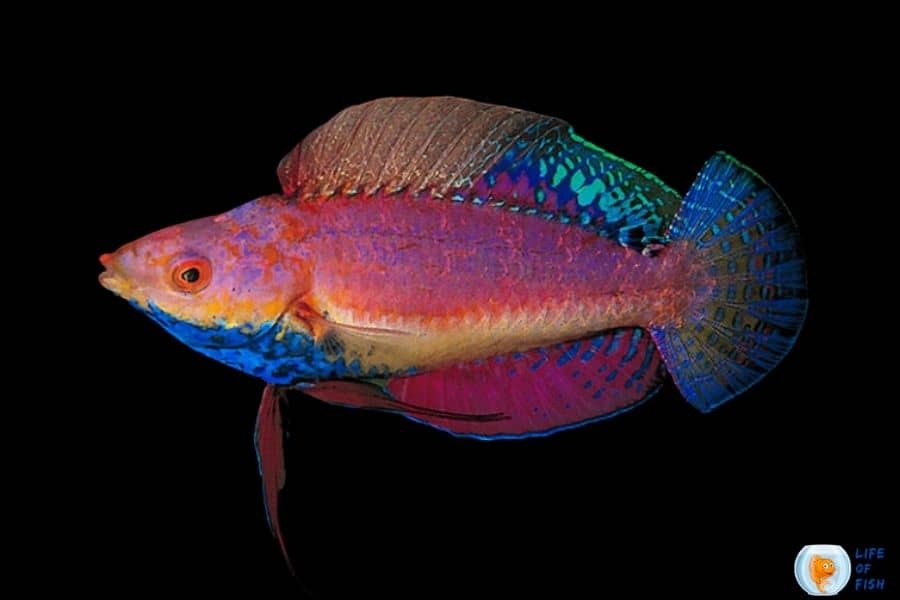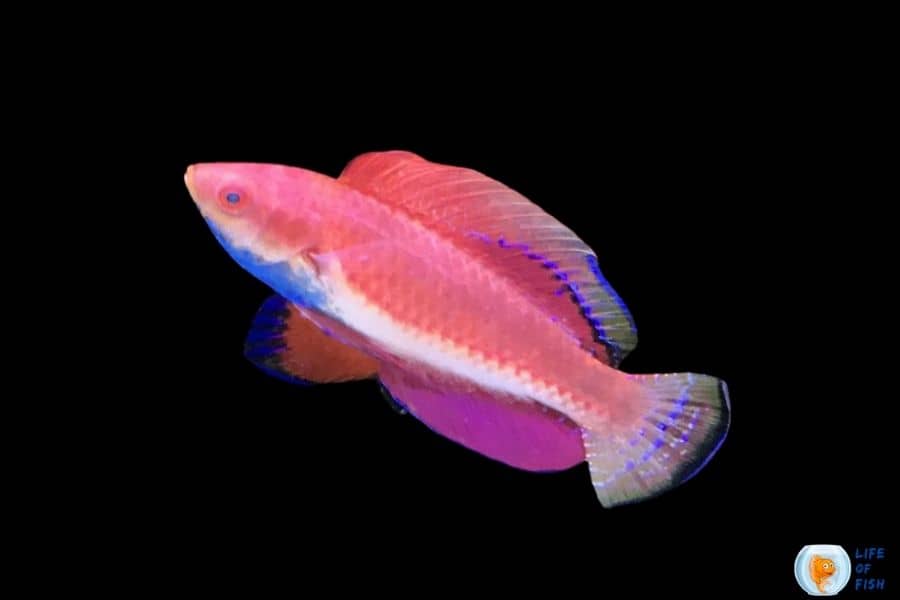Sailfin fairy Wrasse is a magnificent-looking saltwater fish recently introduced to the aquarium trade. This mysterious fish was said to be a rare hybrid between C. rubripinnis and C. tonozukai until lately when they are properly named Cirrhilabrus cyanogularis.

These fish are sold at a higher price tag because of their stunning coloration and rarity, but are they really worth the money? This article aims to provide an insight into these fish so you would know whether or not it is suitable for your aquarium.
One Look Care Guide
Jump To
- 1 One Look Care Guide
- 2 What is Sailfin Fairy Wrasse?
- 3 How big do Sailfin Fairy Wrasse get?
- 4 Are they aggressive?
- 5 Their behavior
- 6 How long do they live?
- 7 Sailfin Fairy Wrasse care
- 8 Sailfin Fairy Wrasse breeding
- 9 Special tips
- 10 How to feed Sailfin Fairy Wrasse?
- 11 Sailfin Fairy Wrasse tank mates?
- 12 Related questions
- 13 Conclusion
| Scientific name | Cirrhilabrus cyanogularis |
| Common name | Sailfin fairy wrasse Blue Throat Fairy Wrasse |
| Care level | Easy |
| Native to | Indonesia and the Philippines off the coast |
| Type | Saltwater fish |
| Color | red, orange, and yellow with purple and blue hues |
| Tank size | 70 gallons |
| Preferred temperature | 72 to 78° F |
| Other water parameters (ammonia, etc.) | pH level: 8.1-8.4 pHHardness: 8-12 dKH Salinity: sg 1.023-1.025 |
| Preferred salinity | sg 1.023-1.025 |
| Size | 4 inches |
| Life Span | 5 -7 years in captivity |
| Temperament | Peaceful |
| Recommended tank mates | Most fish without aggressive and territorial fish |
| Preferred food | zooplankton like krill Mysis shrimp Brine shrim Other similar tiny organisms Pellets and flakes |
| Feeding frequency | Several times per day |
| breeding | Unknown in captivity |
What is Sailfin Fairy Wrasse?
Scientifically named Cirrhilabrus cyanogularis, Sailfin fairy wrasse, or Bluethroat fairy wrasse, is a unique species native to Indonesia and the Philippines. These fish inhabit rubble areas of the outer reefs where they are found preying on crustaceans.
Cirrhilabrus cyanogularis is a recently discovered species and was once tagged as a rare hybrid between C. rubripinnis and C. tonozukai until lately when they are properly named. They are now known as one of the most beautiful fish on the reef. Cirrhilabrus cyanogularis is a saltwater fish perfect for the aquarium. They are reef-safe and will adapt to captive conditions. They are peaceful with other fish and will not bother any corals or invertebrates in the tank.
Appearance-wise, these fish have colorful hues around the body. It has hints of red, orange, and yellow coloring on the body.
On the bottom near the chin, there is a blue color hue. Fins are red-orange, with some having purple accents. This fish has similarities to C. rubripinnis and C. tonozukai, and that’s why many experts believed this was a rare hybrid when they were first found in Sulawesi, Indonesia. Later this species was also found in Philippine waters, and the confusion was finally cleared. Sailfin Fairy Wrasse or Cirrhilabrus cyanogularis is a unique and beautiful fish, but they are not affordable for your reef aquarium.
Want to learn more about wrasse fish? Check out our comprehensive guide to these fascinating creatures!
How big do Sailfin Fairy Wrasse get?
They grow up to 4 inches in length. Although they are small fish, they need a bigger aquarium as they grow bigger.
Are they aggressive?
They are calm and peaceful species that get along well with most fish, provided that they have adequate space to swim and plenty of rocks and caves to hide. These fish are very peaceful and would not go after other reef inhabitants, even the invertebrates like shrimps and snails.
Their behavior
They are outgoing and active fish that darts around the tank and explores all areas, even extending to nooks and crannies. They like to swim and often follow their owners as they observe their activities. These fish are very active and would not stay still in one place for a long time, and they like to search and patrol the reef.
Although they are carnivore fish, they do not harm any other fish or invertebrates as their diet consists of zooplankton. They will explore through the reef to find food but will not harm corals and other invertebrates (unless they are small enough for these fish to eat.
How long do they live?
Since this is a newly introduced fish species, the exact life span of these fish is unknown. However, they seem to live around 5 to 7 years in captivity.
Sailfin Fairy Wrasse care
They are easy to care for species if you know the basics of keeping a reef aquarium. They are saltwater and are compatible with any reef tank.
- Size
They are medium-size wrasse and will grow up to 4 inches. Like any other fish, they need a bigger tank to thrive.
tank size
Although these fish are small, they require a large tank to thrive. Allow adequate space for your fairy wrasse to swim. A tank capacity of at least 70 gallons is ideal.
- How many should be kept together?
You can keep them in solitary or as a group as these fish have a placid temperament. However, if you plan to keep more than one fish, ensure that the tank is large enough to accommodate all the fish. For a group of 5 fish, at least 150 gallons is recommended.

Tank setup
Sailfin fairy wrasse is best kept in reef aquariums. As mentioned before, they need ample space to explore. It is better to provide an environment similar to their natural habitats in East Asia.
Substrate
Since the natural habitats of these fish contain a sandy substrate, it would be best to have a sand substrate at the bottom of the tank.
Decorations
They require plenty of hiding places made of live rock. This will provide shelter from other fish and create a natural environment that they are used to in their natural habitats.
Corals and Plants
This is reef fish and will not bother any corals or plants, provided that you provide plenty of hiding spaces.
Lighting and Temperature
They require moderate lighting and temperature. They are primarily found in the coastal regions, hence requiring temperate water conditions in their surroundings.
Filtration
They require a large and powerful filter that will clean the water and circulate it in a way similar to their natural habitat.
Tank lid
Sailfin fairy wrasses are known as good jumpers. So, it is required to have a tank lid to prevent them from jumping out of the tank.
Water quality condition
These fish can tolerate slight water condition changes, but the water needs to be clean and clear. Frequent water changes are required to maintain the high-quality condition of the tank. Change about 20% of water bi-weekly.
Since these fish are used to living in tropical areas, the water temperature should be around 72 to 78° F degrees. The pH level should be between 8.1 to 8.4, and the hardness should be about 8-12 dKH. These fish prefer specific gravity of sg 1.023-1.025 in their waters.
Sailfin Fairy Wrasse breeding
Being introduced to the aquarium hobby recently and officially recognized in 2018, the reproduction behavior of these fish is still unknown.
The specimens sold at the market are wild-caught ones. However, fortunately, these fish acclimate to the captive environment pretty quickly, within about 3 hours. Male fish usually display increased color intensity during mating. But identifying males from females is generally not easy as both sexes have the same color morph.
However, males typically have a brighter color morph than females, and juveniles, show more aggressive behavior than females. So, it might not be easy for you to differentiate males from females if you are a novice aquarist.
Since sailfin fairy wrasse is a fairy wrasse species, we can assume that they are hermaphrodites, which means they change sex when necessary.
This usually happens when there is no male specimen in a group. The dominant female will change its sex to become the male specimen in that “harem.”
Special tips
Never accommodate related wrasse species with sailfin fairy as they can crossbreed and produce hybrid species. They should be kept in a large tank as they are open-water swimmers. The tank should be well decorated with plenty of hiding spaces, but no very sharp rocks as these fish can get their fins tangled in them.
How to feed Sailfin Fairy Wrasse?
They are carnivore fish, but they are not predators. So, they won’t try to eat any fish or invertebrates in the tank. They mostly go after zooplankton like krill, mysis shrimp, brine shrimp, and other similar tiny organisms.
You can also feed them with processed flakes, live food like bloodworms and brine shrimp, and frozen food like mysis and krill. They usually prefer live food as it is much easier to digest.
They are considered reef safe; however, they may eat invertebrates like sexy shrimp as they are small enough for these fish to eat.
When feeding wrasse, try to provide a varied diet and include vitamin-enriched food like vitamin-enriched brine shrimp and vitamin-enriched mysis shrimps to gain maximum health benefits. If not supplemented with vitamins, these fish may lose their coloration and become weak after some time.
These fish may avoid food when newly introduced to an aquarium but will accept most types of food once acclimated. Fortunately, acclimating will take only hours. As these fish are highly active fish species, they need to be fed several times per day.

Sailfin Fairy Wrasse tank mates?
Since these fish have a peaceful temperament, they will fare well with most other aquarium fish unless they are aggressive and territorial.
As mentioned earlier, these fish are reef-safe. It means they can live in a reef tank with large invertebrates like urchins, polyps, and corals without any problem.
However, they may think of small invertebrates like sexy shrimps as food and try to eat them. So, do not keep them with small invertebrates like sexy shrimps. If you want to keep them with corals, make sure not to place the fish under the stinging tentacles of corals. They do not bother corals and other invertebrates.
They can also cohabit with other non-aggressive fish species. You can keep them with cardinalfish, clownfish, and gobies as they are compatible with each other.
However, do not house other related wrasse species with sailfin fairy wrasses as they may interbreed and produce hybrid species.
They do well when kept in a group as with the same species. But, there should be only one male specimen in the tank with a group of female fish. Otherwise, the male fish may fight with each other until one is killed or seriously wounded.
Note: If you plan to keep a group of these fish, be sure to introduce all the fish into the aquarium while introducing the male fish into the tank. This will avoid a male-to-male aggression problem.
Related questions
Are Sailfin Fairy Wrasses rare?
They are not rare and abundant in their natural habitats. However, they are not always available in the aquarium trade. They are mostly sold when they are juvenile fish species, and their price is much higher than other wrasse species.
Can I keep Sailfin Fairy Wrasse with other wrasse species?
When it comes to compatibility, sailfin fairy wrasses are very peaceful. They can be kept with other reef-safe wrasse species as well as the clownfish, cardinalfish, and goby species without any problem. However, it is recommended that you not house them with other related wrasse species as they may interbreed and produce hybrid species.
How big does a Sailfin Fairy Wrasse grow?
They grow up to 4 inches (10 cm) in length.
How long does a Sailfin Fairy Wrasse live?
They can live up to 6 years in the aquarium.
Is fairy wrasse reef safe?
Yes, they are reef-safe and will not bother corals and other invertebrates in the aquarium.
Does fairy wrasse eat pests?
No, they do not eat pests and algae. They eat zooplankton, live copepods, mysid shrimp, and other meaty foods in the aquarium.
How much is a sailfin fairy wrasse?
The average price of a fresh one is around $90 – $150. They are not cheap fish to afford, but they surely will make a show in your tank.
Conclusion
The sailfin fairy wrasse is a beautiful and peaceful species that does well with most fish, provided they have adequate space to swim and enough rocks and caves for shelter. If you’re looking for an exciting addition to your saltwater aquarium or want something new and exciting in your home aquarium, this may be a perfect choice.
Read Next : Eight line Flasher Wrasse Care Coris Wrasses | 12 Incredible Coris Wrasses And 2 Wrass-Like Fish |
